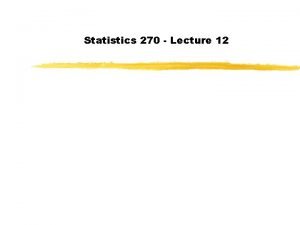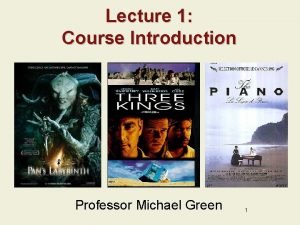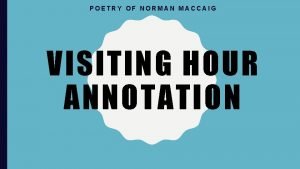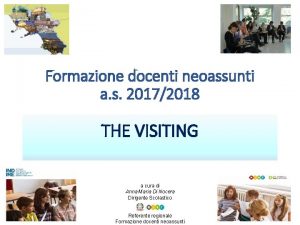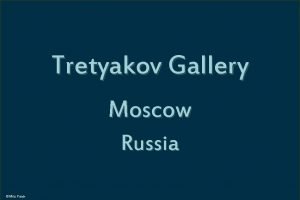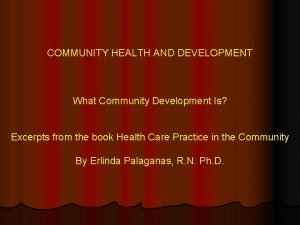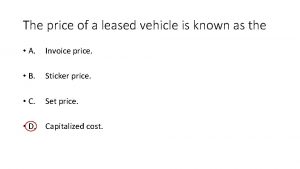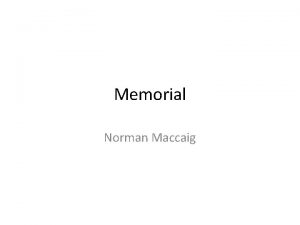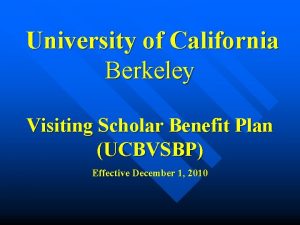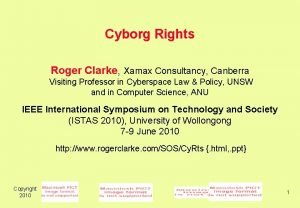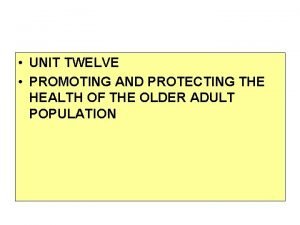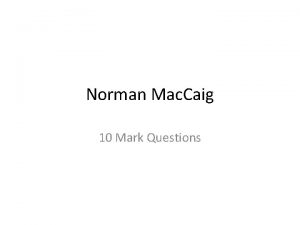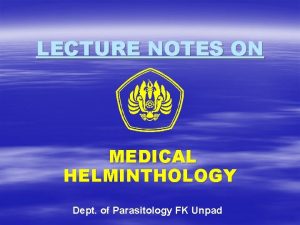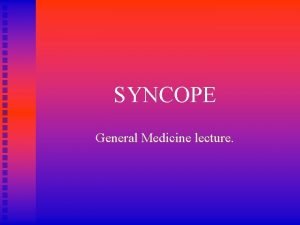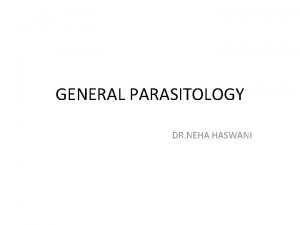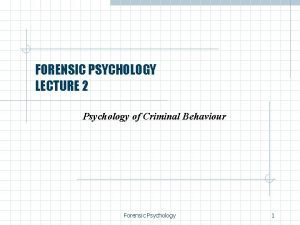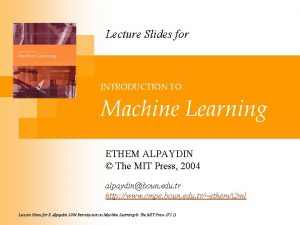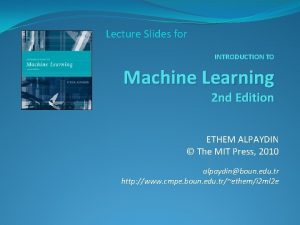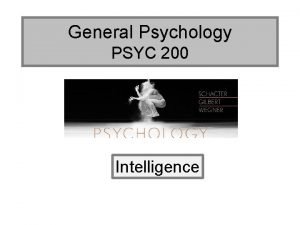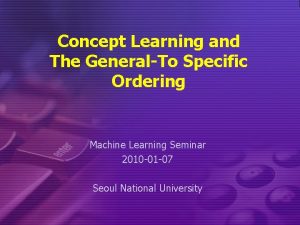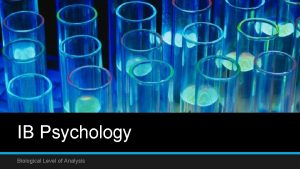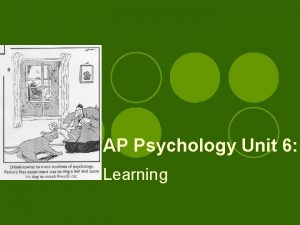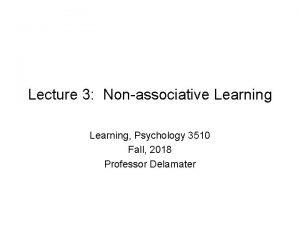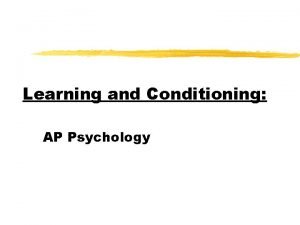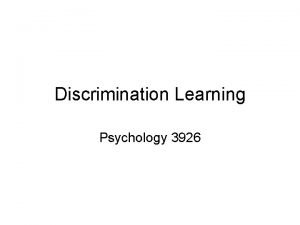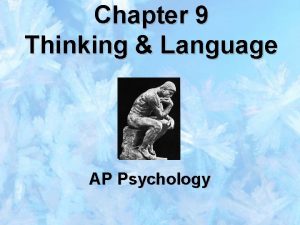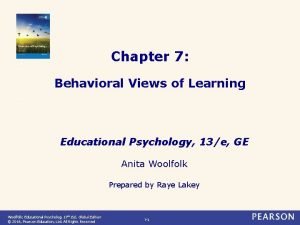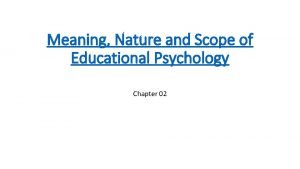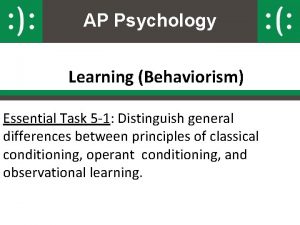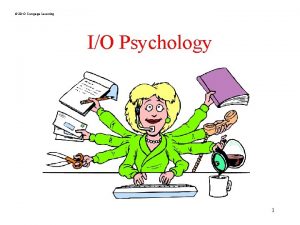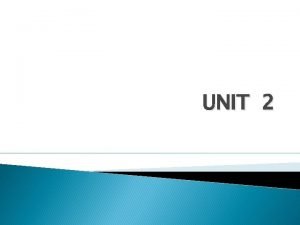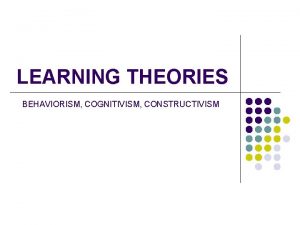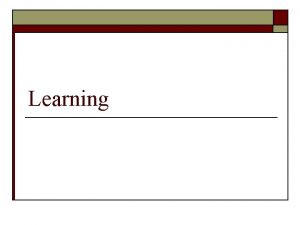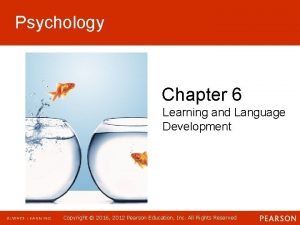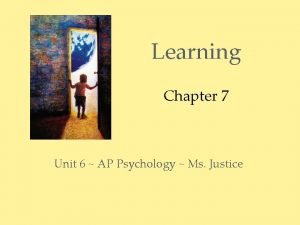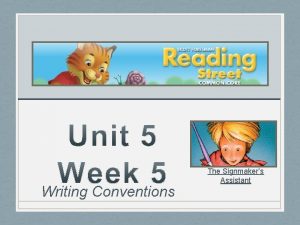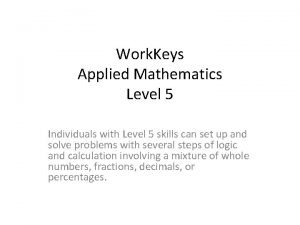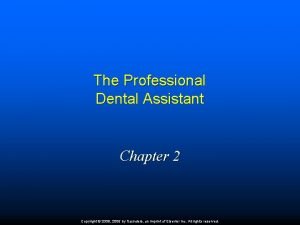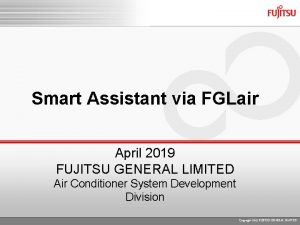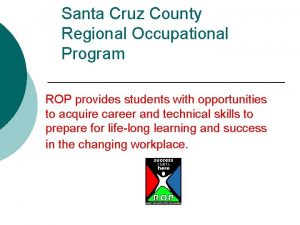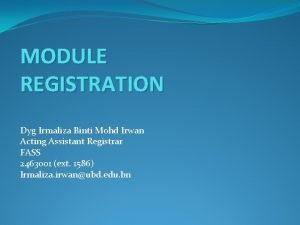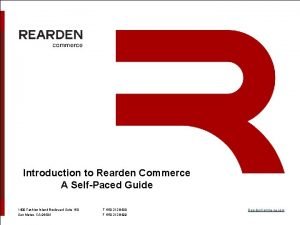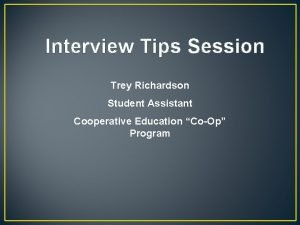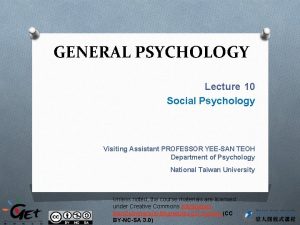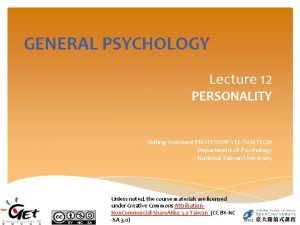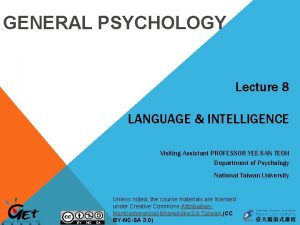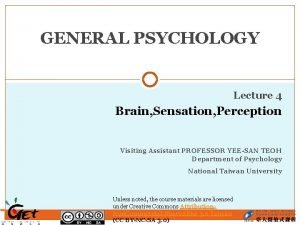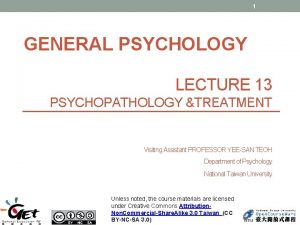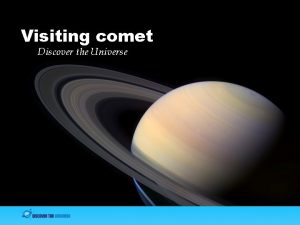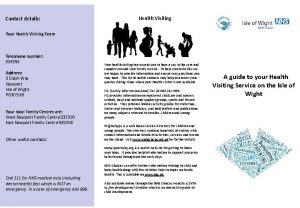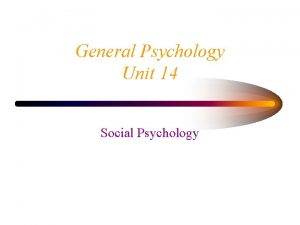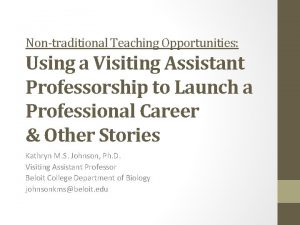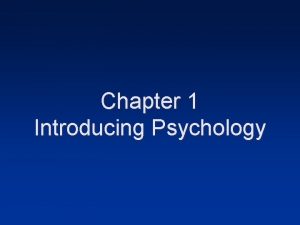GENERAL PSYCHOLOGY Lecture 6 LEARNING Visiting Assistant PROFESSOR








































































- Slides: 72

GENERAL PSYCHOLOGY Lecture 6 LEARNING Visiting Assistant PROFESSOR YEE-SAN TEOH Department of Psychology National Taiwan University Unless noted, the course materials are licensed under Creative Commons Attribution. Non. Commercial-Share. Alike 2. 5 Taiwan (CC BY-NC-SA 3. 0)

LEARNING Habituation Classical Conditioning Operant Conditioning

Habituation • The decline in an organism’s response to a stimulus once the stimulus has become familiar. • Important function – Helps us ignore old news to allow us to pay attention to unfamiliar stimuli that may signal danger or an unexpected opportunity. • Ignore inputs that are already familiar & unimportant and focus on the novel inputs.

Dishabituation • Increase in organism’s response to a familiar stimulus caused by a change in the stimulus. • Important function – calls attention to newly arriving information, which may signal danger or an unexpected opportunity.

CLASSICAL CONDITIONING

Pavlov’s Dogs wikipedia: Илья. Го(грохотайло)

History • Pavlov was studying digestive physiology by studying the secretion of saliva in dogs. • Found that salivation could be triggered by formerly neutral stimuli, like the sight of a food dish.

2 types of responses & 2 types of stimuli UR • Unconditioned Response US • Unconditioned Stimulus CR • Conditioned Response CS • Conditioned Stimulus

Unconditioned Response (UR) • Biologically determined reflex. • Triggered by a certain stimulus independent of learning. • E. g. Salivation occurs reflexively when food is placed in the mouth. • Salivation = UR • Food in mouth = US

Unconditioned Stimulus (US) • Trigger for Unconditioned Response. • E. g. Food in mouth is the trigger for the dog to salivate

Unconditioned Linkage between the US & UR is biological, nor learned.

Conditioned Response • Response triggered by some initially neutral stimulus (CS) as a result of pairings between that CS and an unconditioned stimulus (US). • The CR is typically not identical to the UR, although it is often similar to it. • E. g. If food in dog’s mouth (US) is paired with the sound of a bell (CS), the dog will salivate (UR), with repeated pairings, soon the dog will salivate (CR) to the sound of a bell (CS). • The CR will be less intense than the UR.

Conditioned Stimulus • Initially neutral, that comes to elicit a new response to being associated with the unconditioned stimulus (US) through repeated pairings. • E. g. If a neural stimulus, like the sound of a bell (CS) is paired with a US, like food placed in the mouth, the CS will be associated with the US, and the dog will salivate at the CS.

Conditioned Linkage between the CS & CR is learned through conditioning (associating the CS with the US)

Acquisition of Conditioned Responses Learning is Gradual The strength of the CR slowly grows as the animal experiences more and more pairings of the CS & US.

Second-Order Conditioning • A neutral stimulus is paired with some already established CS and through repeated pairings, the new CS begins to elicit the CR. Learn to associate Bell + Food (1 st order) Learn to associate Light + Bell (2 nd order) Light becomes signal for bell which is associated with food

Characteristics of Classical Conditioning Extinction Generalization Discrimination Contingency

Extinction • Weakening of the CS to elicit the CR, due to unreinforced presentations of the CS. • Undo previously learned CR, so that the response will no longer be produced. • CR will eventually disappear if the CS is presented several times by itself, without the US.

• Extinction does not mean forgotten. • Mere passage of time is not enough to undo conditioning. • Animal learns that the association between the CS and UR is no longer active. • But………

• If we pair the US with the CS again, we can recondition the animal. • Reconditioning occurs much more quickly, because the animal retains some memory of the CS. • When animal remembers that the CS used to signal the US and produces the CR in anticipation that the CS might signal the US again = spontaneous recovery

Example of Extinction & Spontaneous Recovery Treating Anxiety Disorders Using Exposure Therapy • Person is exposed to a specific stimulus or situation (CS) that has been a source of anxiety (e. g. heights, elevators) • But person is kept safe and comfortable so there is no fearful US associated with the CS. • Repeated pairings (CS without US) = extinction of the CR (feelings of anxiety). • However, if after some time the person is suddenly exposed to the CS, the CR might follow.

Stimulus Generalization • Animals respond to a range of new stimuli, provided that these stimuli are sufficiently similar to the original CS. • E. g If a light (CS) has been conditioned to elicit salivation (CR), the dog may salivate even if the light is slightly brighter or slightly dimmer than the original CS. • However, the greater the distance between the new stimulus and the original CS (e. g. very loud bell and very soft bell), the weaker the CR will be.

Discrimination • Process of learning to respond to certain stimuli that are reinforced, and not to others that unreinforced. • Example: Red light (CS) is paired with the blast of a horn (US) which produces a startled response (UR). Red light alone (CS) produces startled response (CR). Alternate trials of red light plus horn and orange light and no horn = animal learns to discriminate the colors and will only startle to red light.

CS as a Signal • The rate at which conditioning develops depends on how the CS and the US are related to each other in time. Rate of Presentation Effectiveness of Pairing US Before CS Not Effective CS & US Simultaneously Less Effective US shown few sec after CS Effectiveness Declines Sharply US presented 0. 5 Sec after CS OPTIMUM

• CS warns (signals) the organism that the US is coming so it can prepare itself. • If the CS and US are presented too far apart, the organism might not connect the CS with the US. • IF CS & US occur simultaneously, or if US comes before CS – CS cannot signal that the US is coming (it’s already happened)

Contingency • Contingent relationship exists when one stimulus (CS) reliably occurs when another stimulus (US) is about to appear. • First stimulus can be used to accurately predict the arrival of the US. Contiguity • When stimuli occur close together in time. • Appears that the CR is acquired only when the CS predicts what is going to follow.

Surprise & Expectations • If an animal is in a situation in which the CS is followed by the US 90% of the time, the animal will end up with strong expectations for what’s going to happen next whenever it happens. • Animals have a set of expectations based on experience.

Relationship between the CR & UR • CR and UR are not the same. • Animal reacts differently to CS than the US. • CS tells animal to get ready so the CR is the adjustment the animal makes in preparation for the US. • Example: Bell (CS) signals food (US) so mouth is moistened (CR) in anticipation – the food (US) then produces more saliva.

EXAMPLE OF CLASSICAL CONDITIONING Body’s Responses to Drugs

Conditioning & Compensatory Responses • Drug tolerance o Decrease in the response to a drug, usually resulting from continued use. • Drug dependence & cravings o Inability to function without the drug. o Overwhelming desire for yet another dose. o Cravings accompanied by increased sensitivity to pain. o Depression. o Overproduction of fluid in person’s mouth & mucus membrane.

Homeostasis – Stable environment that exists inside our bodies. • US = Heroin • UR = Body’s natural response to the drug. • CS = Stimuli that signal the drug is about to arrive (sight of needle, thought about drug) • CR = Opposite of the UR – since body’s mechanisms of homeostasis want to cancel out the effects of the drug.

Body’s Compensatory Response • Internally produced response. • Body seeks to reduce the effects of some external influence by producing a reaction opposite in its characteristics to those of the external influence. Example: • CS causes body to produce an increase in pain sensitivity in response to decrease in pain sensitivity caused by heroin = cancels out heroin’s reaction & produces drug tolerance & homeostasis.

• No compensatory response when exposed to drug for the first time. • After repeated exposures to the drug, learning occurs, and the compensatory response occurs. • Person preserves homeostasis but also gets drug tolerance effects.

Drug cravings • When a compensatory response occurs because the body is anticipating the arrival of the drug, but no drug is actually available… • Person will experience the compensatory response on its own – depression, pain sensitivity – drug cravings.

OPERANT CONDITIONING Skinner

Thorndike & the Law of Effect Edward Thorndike’s photo courtesy of Science Photo Library Cats in a Puzzle Box • Problem for cat to solve. • How to open door and escape from box to get reward. • Cats learnt solution gradually, with no sudden improvement.

Law of Effect • The tendency of a stimulus to evoke a response is Strengthened if the response is followed by reward. ii. Weakened if the response is not followed by reward. i. • If an animal makes a response and reward follows shortly, the response is more likely to be performed again.

Skinner & Operant Behavior • Operants = Instrumental response defined by the effect it has (the way it operates) on the environment. i. ii. Operant followed by a positive consequence is more likely to be repeated in the future. Operant followed by a negative consequence is less likely to be repeated in the future. Behavior can be changed by providing or removing rewards and punishments.

Classical Conditioning Operant Conditioning Builds on a response (UR) that is automatically triggered reflexively by a stimulus (US) Involves behaviors that are voluntary. Learning the association between two stimuli (US & CS) Learning the association between response and stimulus (the operant and a reward) Learning trials typically involve presentation of CS followed by a US Learning trials typically involve a response followed by a reward or reinforcer.

Reinforcers • Presentation of something good or the termination or prevention of something bad. • Increases likelihood of the response occurring again. Examples • Receiving something good (candy, gold stars, praise, etc. ) • Termination or prevention of something bad (avoiding being grounded, terminating loud noise)

A Reinforcer can generally be determined only after a trial: If a response is repeated to gain the reward…the stimulus is a reinforcer.

Discrimination • Discriminative stimuli = external stimuli that signal a particular relationship between a response and the reinforcer. • Positive discriminative stimulus (S+) • Negative discriminative stimulus (S-) Example: • Green light = S+ when it signals to a bird that it will get food if it hops on a lever. • Red light = S- which indicates that action will not lead to reward.

Generalization – same as CC • Animals respond to a range of new stimuli, provided that these stimuli are sufficiently similar to the original discriminative stimulus S+. • However, the bigger the difference between the new stimulus and the original S+ (e. g. very bright light and very dim light), the weaker the response will be.

Contingency – Same as CC • There needs to be some predictive relationship. • Response needs to be predictive of the reward, so that the probability of getting the reward after the response is greater than the probability of getting the reward without the response. • Predictability helps give animal control.

LEARNED HELPLESSNESS A Contingency Breakdown

What is learned helplessness? • Condition created by exposure to inescapable, aversive events. • Impairs or prevents learning in subsequent situations in which escape or avoidance is possible. • If there is no contingency between acts and outcomes – no point in trying.

Seligman’s Dog Study • Two groups of dogs received same amount of electric shocks. • 1 group given control – could turn off shock by pressing a panel. • 1 group had no control. • Dogs with control in 1 st task learned to escape & avoid shocks in next task. • Dogs with no control in 1 st task did not try to escape in next task.

BEHAVIORAL CONTRAST & MOTIVATION

Behavioral Contrast • Organism seems to evaluate a reward relative to other rewards that are available or that have been available recently. • Example: A teen is not likely to be willing to sweep the floors for $100 if he received $200 the last time he swept the floors.

Motivation according to type of reward INTRINSIC • Reward serves some internal need. • Engage in activity because of the pleasure of the activity. EXTRINSIC • Reward serves some external need. • Under control of experimenter.

Schedules of Reinforcement • Rules about how often and under what conditions a response will be reinforced. • Ratio Schedule – person/animal is rewarded for producing a certain number of responses. • Interval Schedule – Person/animal is rewarded for producing a response after a certain period of time has passed.

LATENT LEARNING THAT TAKES PLACE WITHOUT ANY CORRESPONDING CHANGE IN BEHAVIOR….

Tolman’s Rats • Had rats exploring a maze without a reward for 10 days. • No change in behavior. • On 11 th day, gave food as a reward for getting to the end of the maze. • The rats ran to the end virtually without error. • Knowledge of maze acquired but not used until a reward was given to motivate the rats.

OBSERVATIONAL LEARNING

Observational Learning • Process through which we watch how others behave and learn from their example. • This type of learning is found in many species. Mirror Neurons • Located in frontal lobe, near motor cortex • Fire whenever an animal performs an action, and whenever the animal observes someone else performing the same action.

Bandura’s Classic Bobo Doll Study (1969, 1977) • Children who had observed an adult behaving aggressively with a Bobo doll were more likely to behave aggressively with the Bobo doll… • Compared with children who viewed an adult who did not behave aggressively with the Bobo doll. AP Psychology Learning

Neural Basis for learning

Where? • Brain circuits underlying fear conditioning are centered in the amygdala. • Brain circuits underlying eyeblink conditioning are centered in the cerebellum. • Conditioning with a long delay between the CS and the US typically involves the hippocampus.

Neural Plasticity • Capacity for neurons to change the way they function as a consequence of experience. • Involves changes at the synapse – how neurons communicate with each other.

Presynaptic Facilitation • Some neurons, after learning, end up sending a stronger signal than they did before. • May release more neurotransmitter than they did before learning.

Postsynaptic Changes Long-term Potentiation (LTP) • Postsynaptic neuron becomes more sensitive (potentiated) to the signal received from the presynaptic neuron, which lasts for days or weeks (long-term).

Formation of New Synapses • Learning can lead to the creation of entirely new connections among neurons – new synapses. • Changes take place mostly on the dendrites – new dendritic spines.

Consciousness

Two Aspects of Consciousness Level of alertness or sensitivity • Distinction between being dimly aware of something and being highly alert. • Corresponds to brain sites: thalamus or reticular activating system. • Alertness is disrupted with damage to system that controls overall arousal and cycling of sleep & wakefulness.

Content of Consciousness • May be thinking about the past, present, or future. • Various contents of consciousness require different brain sites. • In dreaming, we are conscious of a richly detailed content, but our level of sensitivity to the environment is low.

DRUG-INDUCED CHANGES IN CONSCIOUSNESS Depressants, Stimulants, Marijuana, Hallucinogens

Depressants • Drugs that decrease activity in the nervous system. • Alcohol, sleeping pills, drugs used to treat anxiety.

Effects of alcohol • At low doses: Produces feelings of pleasure & well-being. • But also depresses activity in the neural circuits that controls our impulses. • Narrowing of attention. • Thinking tied to here and now, little attention to possible consequences of one’s actions. • Effects derived from actual impact on brain and people’s expectations: When participants ‘believed’ that they had consumed alcohol, they behaved with less inhibition.

Effects of Sleeping Pills, Anti-Anxiety Drugs • Can produce physical & psychological dependence. - Withdrawal symptoms after prolonged use quite likely – enhanced anxiety, insomnia. • Can produce drug tolerance. - When person becomes less sensitive to the drug, higher & higher doses are needed to achieve the same effects. - Risks of high doses causing cognitive impairment or even coma.

Stimulants • Drugs that stimulate the nervous system and broadly increase the level of bodily arousal. • Can raise blood pressure, increase heart & breathing rate. • Increase overall alertness, boost energy. • Decrease the need for sleep. • Can lead to psychological & physical dependence withdrawal symptoms. • Caffeine, cocaine, amphetamines (incl MDMA/ecstasy), Ritalin.

Effects of Cocaine • Temporary rush of excitement and euphoria. • Following arousal, person comes crashing down, feels fatigue, depression. • Risk of dependence. • Feelings of paranoia. • Risk of cardiac arrest, respiratory problems.

Copyrights Page 6 6 Work License Author/Source Wikipedia: unknown http: //commons. wikimedia. org/wiki/File: Ivan_Pavlov_LIFE. jpg 2012/04/11 visited Wikipedia: Илья. Го(грохотайло) http: //en. wikipedia. org/wiki/File: Monument. IPAVLOV. jpg 2012/04/11 visited 16 National Taiwan University YEE-SAN TEOH 36 This photo is from Science Photo Library http: //www. sciencephoto. com/media/228950/enlarge and used in accordance with its terms of use http: //www. sciencephoto. com/terms. html for educational purpose only. 36 Wikipedia: Jacob Sussman http: //en. wikipedia. org/wiki/File: Puzzle_box. jpg 2012/04/11 visited 56 AP Psychology Learning https: //laurensaplearning. wikispaces. com/Bandura 2012/04/11 visited
 Promotion from associate professor to professor
Promotion from associate professor to professor Fok ping kwan
Fok ping kwan A college professor never finishes his lecture
A college professor never finishes his lecture Professor green lecture 1
Professor green lecture 1 01:640:244 lecture notes - lecture 15: plat, idah, farad
01:640:244 lecture notes - lecture 15: plat, idah, farad Cuadro comparativo de e-learning
Cuadro comparativo de e-learning Visiting hour norman maccaig
Visiting hour norman maccaig Please sit at the table
Please sit at the table Home visiting definition
Home visiting definition Visiting neoassunti
Visiting neoassunti Visiting nurse services des moines
Visiting nurse services des moines Unit eleven fitness
Unit eleven fitness Andrei rubkev
Andrei rubkev Why is community health important
Why is community health important Madeline wants to purchase a larger house
Madeline wants to purchase a larger house Aunt julia bbc bitesize
Aunt julia bbc bitesize Visiting scholar berkeley
Visiting scholar berkeley Prosthete
Prosthete Home visit ppt
Home visit ppt Aunt julia commonality
Aunt julia commonality Fordham university rose hill campus map
Fordham university rose hill campus map Dyphilidium caninum
Dyphilidium caninum General medicine lecture
General medicine lecture General parasitology lecture notes
General parasitology lecture notes Social psychology lecture
Social psychology lecture Forensic psychology lecture
Forensic psychology lecture Introduction to psychology lecture
Introduction to psychology lecture Aims of health psychology
Aims of health psychology Introduction to machine learning ethem alpaydın
Introduction to machine learning ethem alpaydın Ethem alpaydin
Ethem alpaydin Machine learning lecture notes
Machine learning lecture notes Planos en cinematografia
Planos en cinematografia Where did general lee surrender to general grant?
Where did general lee surrender to general grant? Discussion questions about intelligence psychology
Discussion questions about intelligence psychology Positive psychology ap psychology definition
Positive psychology ap psychology definition Group polarization
Group polarization Fundamental attribution error ap psychology
Fundamental attribution error ap psychology Explain methods of psychology
Explain methods of psychology Social psychology is the scientific study of:
Social psychology is the scientific study of: Health psychology definition ap psychology
Health psychology definition ap psychology Concept learning and the general-to-specific ordering
Concept learning and the general-to-specific ordering Ib psychology learning outcomes
Ib psychology learning outcomes What is insight learning in psychology
What is insight learning in psychology Latent learning psychology definition
Latent learning psychology definition Factors affecting learning in psychology
Factors affecting learning in psychology Latent learning psychology definition
Latent learning psychology definition Non associative learning psychology definition
Non associative learning psychology definition Factors affecting learning in psychology
Factors affecting learning in psychology Difference between classical and operant conditioning
Difference between classical and operant conditioning Mullerian vs batesian mimicry
Mullerian vs batesian mimicry Linguistic determinism ap psychology
Linguistic determinism ap psychology Behavioral views of learning
Behavioral views of learning Discuss the nature of educational psychology
Discuss the nature of educational psychology Non-associative learning definition
Non-associative learning definition Behaviorism ap psychology
Behaviorism ap psychology Portage learning abnormal psychology
Portage learning abnormal psychology Cengage learning psychology
Cengage learning psychology Learning is defined as:
Learning is defined as: Constructivism vs behaviorism vs cognitivism
Constructivism vs behaviorism vs cognitivism Intermittent schedule of reinforcement
Intermittent schedule of reinforcement Chapter 6 learning and language development
Chapter 6 learning and language development Unit 6 learning ap psychology
Unit 6 learning ap psychology The signmaker's assistant quiz
The signmaker's assistant quiz As a laboratory assistant you measure chemicals
As a laboratory assistant you measure chemicals Chapter 2 the professional dental assistant
Chapter 2 the professional dental assistant Fglair google home
Fglair google home Rop medical assisting
Rop medical assisting Mia irwan
Mia irwan Cisco configuration assistant (cca)
Cisco configuration assistant (cca) Kpu health care assistant
Kpu health care assistant Reardon commerce
Reardon commerce Interview questions for student assistant
Interview questions for student assistant Ibm support assistant workbench
Ibm support assistant workbench


